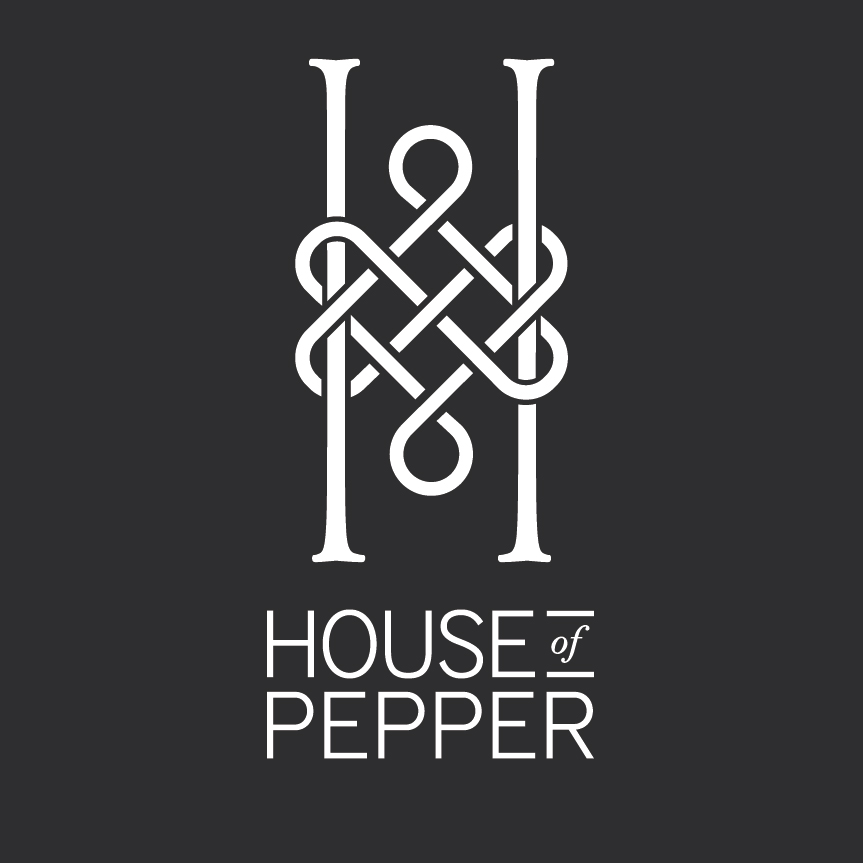Supreme Craftsmanship of Celtic Art
My Journey to Celtic Art. You know you have stepped into a spiritual realm when a work of art takes your breath away. Especially so, if it is not the original but a reproduction in a book or a low-resolution image online. This happened to me when I came across a book on the illuminated manuscript of the Book of Kells from the Middle Ages by Bernard Meehan. A walk into the splendour of Celtic Art from the desktop and paperbacks.
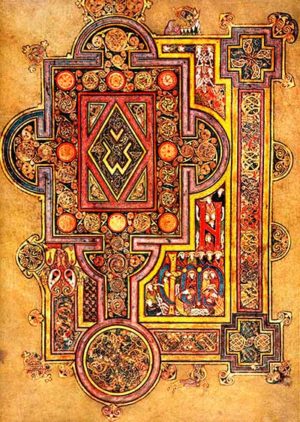
St Luke’s Gospel Quoniam
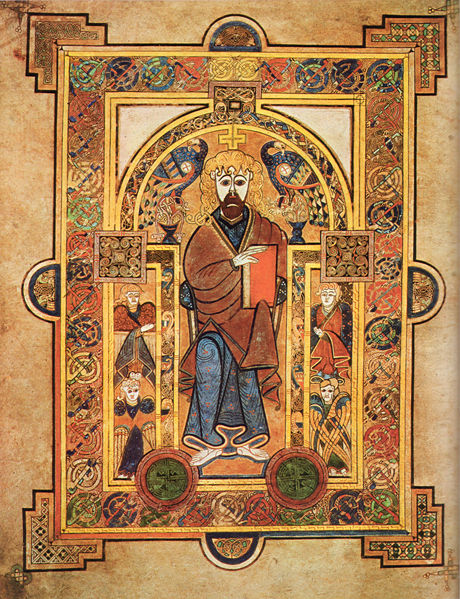
Christ Enthroned Folio 32V
In this post I would like to share how I came to work in this area. First, I discovered an ancestry linking me to old Europe and the history of Scotland and second, I was intrigued and fascinated as an artist by the Celtic design and style. I wanted to know how to work the flowing line of knotwork and how to unlock the secret of interlacing. Next, I was stunned by the detail and intricate beauty of the Book of Kells and later the Lindisfarne gospels and the Book of Darrow. The culture and art from this ancient world pleasantly removed me from the hype and spin of current Gallery art blockbusters and exhibitions. I was seduced by the astonishing and unique Celtic style going back some 2,500 years. The Book of Kells lifted me to another place. Such visionary splendour and beauty transcend the ordinary world.
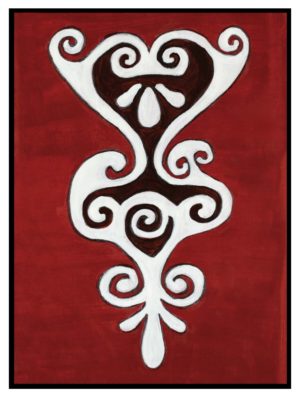
Design from metal torque
In the local library I discovered Celtic and Old Norse Designs by Courtney Davis, and the Early Celtic Designs (mostly La Tene) with patterns for artists and teachers by Ian Stead and Karen Hughes printed by the British Museum. These drawings were taken from artefacts such as actual stone monuments, ornate crosses, bronze helmets, shields, sword scabbards, clay bowls and pots, cauldrons, flagons, and various ornaments including torques and superb jewelry. I was in luck because I had discovered somewhere to start! What you see on the website started from those design drawings found on such ornaments.
My exploration reached further to include a series of Celtic Design guidebooks with wonderful drawings and instructions by Aidan Meehan and the master George Bain from his book Celtic Art: The Methods of Construction. Later I searched online and have just kept going.
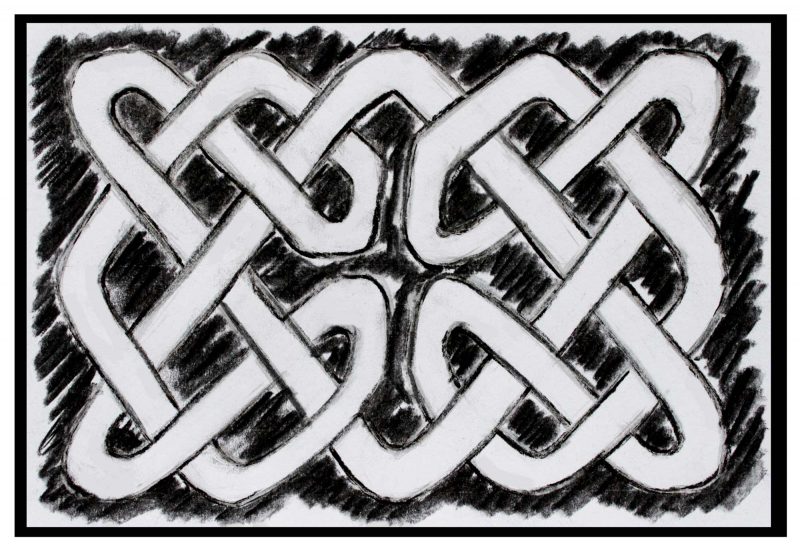
Charcoal Knot
Who are the Celts?
The best answer that I can give, would be that the Celts have a shared cultural heritage that crosses many borders and languages and covers a huge geographical area and time zone! The oldest part can be found near Eastern France, North Italy, South Germany, North Switzerland, Austria, Turkey, and Spain. The Greeks named the people living north of the Alps as Keltoi and Celt is derived from that. These old Celtic tribes from western and central Europe have a heritage going back to prehistory. As outsider tribes on the move, they were labelled as barbarian tribes from the North -again by the Greeks. How such an evolved and elaborate art and culture can be labelled barbarian is a misnomer. History takes us to the Roman Empire and war, to the Roman invasion and pervasive control in Europe and to Christianity and much more (a history too vast to detail) and to the near death of the Celtic culture. Fortunately, Celtic beliefs and customs were slowly revived in Ireland and not lost. The legends and myths survived, and manuscripts and other items were later discovered in archaeological projects. Ancient Celtic artefacts and treasures are still being found and motifs and symbols still leave many unanswered questions.
Today, the old Celtic traits have survived in the western European provinces such as Brittany, Cornwall, Ireland, Isle of Man, Scotland, and Wales. Unlike the Christian Romans, the Celts believed in the ‘Otherworld’ and a paradise after death rather than a Christian underworld of death and mortality. The Celts looked to nature for inspiration and, like the Druids before them, honoured the seasons and farming cycles. In early pagan belief they have their own ancient Gods and Goddesses and a rich mythology of fantastic legends and stories.
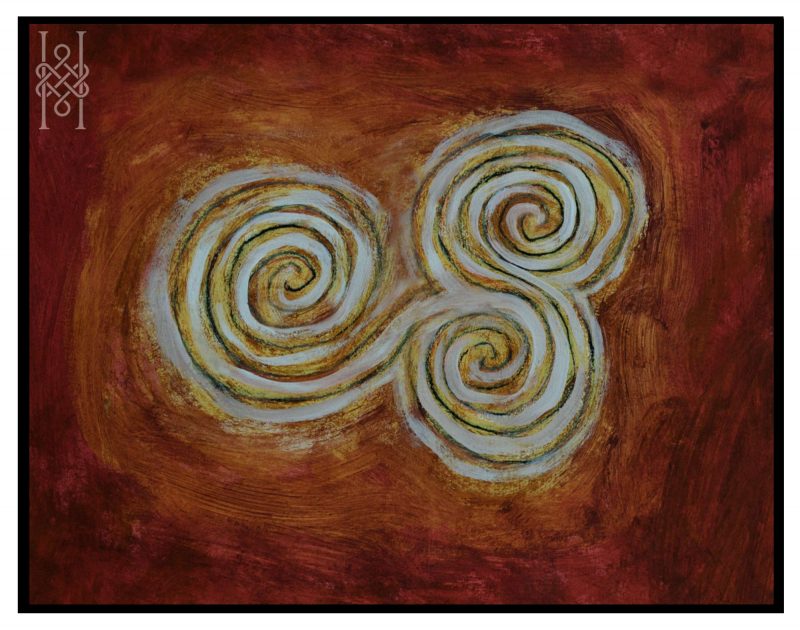
Newgrange-Stone-Spirals
Later the missionary Christian church tried to demonize pagan beliefs as supernatural and evil and caused huge upheavals and the deaths of thousands of women as if these beliefs were connected to Satan. Celtic belief is not bipolar and not based on good and evil or an ‘original sin’ in the Garden of Eden; and the Christian church eventually failed to destroy and suppress all the old beliefs. Celts believe they are the caretakers of nature, not rulers over it. Plants and animals are respected and have their own cosmic spirit and place in the global ecosystem. Born of the Earth and returned to Earth with no hierarchy of order in mind, body, or spirit. Round and round like the knotwork, equal and travelling in spirals and circles through the journey of life, mostly in pairs and sometimes alone. Recent happenings with climate change inspire a return to nature and the care of plants, a return to the growing of vegetables and fruit trees and a restoration of delicate ecosystems and the natural events of seasons and Earth systems.
What is Celtic Art?
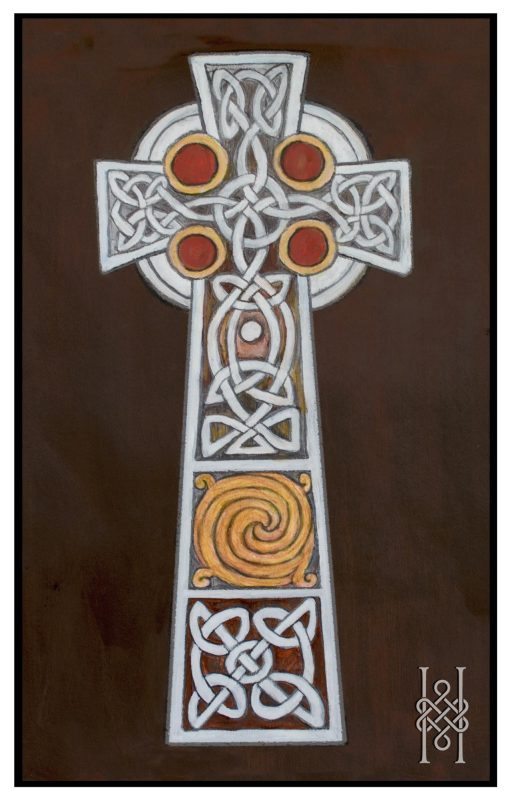
Ornamental Celtic Cross
These very gifted artists had the ability to combine and reinvent everything they saw into something new and unique. At the same time as the ancient Greeks were exploring realism the Celtic artists in Northern Europe were using curvilinear patterns in an abstract geometric style with few figures. They soaked up the Classical and Oriental influences with geometry and a carefully balanced positive and negative layout, sometimes symmetrical. Depicting beautiful rhythms in a curvilinear pattern and with acute spatial awareness, the Celtic artists developed a distinctive style of their own. They combined and explored surrounding influences. During the Celtic Christian period Pagan and Christian art evolved together in the monastic communities as Insular Art. The Celtic Cross with the wheel of the seasons as four elements and the Christian crucifix is one of those icons.
The Celtic identity is shown on the ornaments of the time with spirals and triskeles, palmettes, lotus flowers, S forms, lyres, tendrils, scrolls and interlacing. Knotwork would be the best known of the Celtic patterns, sometimes interwoven with birds, animals, fish, people, letters, and initials. Gospel figures gaze directly at the viewer from the manuscript pages and knotwork frames the image in a border. Knots in a single continuous line are well known. There is no beginning and no end, and it is drawn under and over as it progresses along the drawn path.
The Brilliant Celts
The design component is strong and this, for me, is what makes Celtic art so outstanding and so brilliant. Space in the designs is mostly closed and filled. It is the opposite today, strangely, where Minimalist thinking eliminates clutter and gives power to the empty open space. In the Gospel manuscripts and especially in the Book of Kells every empty space and corner is filled. The monks could take any empty shape and fill it with decorative little scrolls and spirals. The Celtic style is a forerunner to the extravagant flourishes and swinging lines of Rococo, Baroque, Gothic and Art Nouveau periods. If not forerunner in style, then certainly Celtic art has had a huge influence on these periods of Western art.
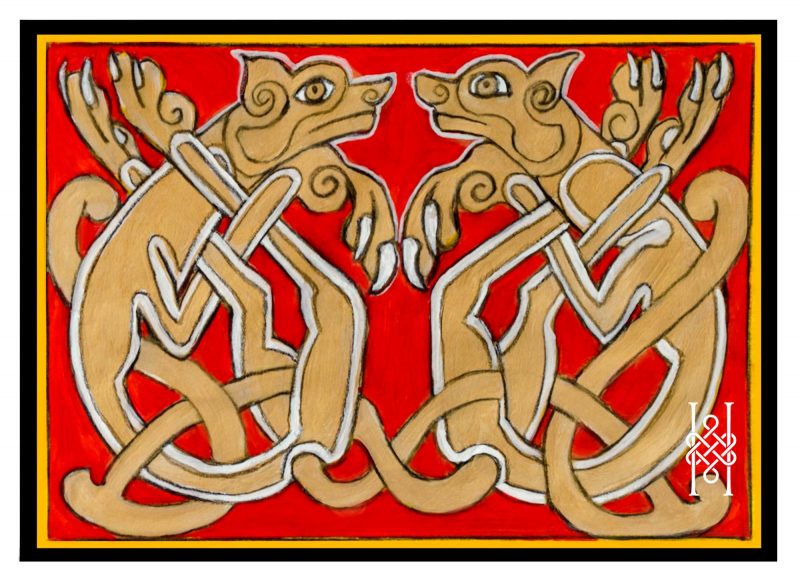
Dog Pair from Book of Kells
Medieval Illuminated Manuscripts
The divinely inspired and astonishingly beautiful Book of Kells, the Lindisfarne Gospels and the earlier Book of Durrow are the greatest and most precious records of Celtic Christian art. The Celtic style combines Byzantine art, Mediterranean, Classical Greco-Roman, Anglo-Saxon, Viking/ Norse and Early Celtic Art known as Hallstatt and La Tene, and Pictish art from Northern Scotland. In the monastery Insular Art, it was forbidden to imitate nature and draw animals, birds, and people realistically as a mark of respect to divine creation. Only those who had already died could be drawn realistically and so with Celtic Christian art at the time of the Medieval manuscripts Saints, Angels and Christ were shown closer to the human form. Animals, birds, and figures were twisted and distorted out of the normal body shape. Sometimes extensions from ears, tails and limbs cycle back to curl and interlace or even bite their own body or the body of another. These unnatural, entangled positions of the body were balanced and expressive.
The monks worked by candlelight in the Christian monasteries to document and illustrate the gospel pages. It is hard to imagine how they could visualize such exquisite designs on the calf vellum page in such cold and bleak surroundings and in such small formats. The Book of Kells, a most treasured and celebrated illuminated manuscript, survives today and is housed in Trinity College, Dublin where a different page is shown each day. Art lovers and visitors attend in the thousands to view the great masterpiece from c800 AD. The Kells’ monks still linger in my mind as supreme artists of creative passion and spirit in a time of turmoil in Medieval Europe.
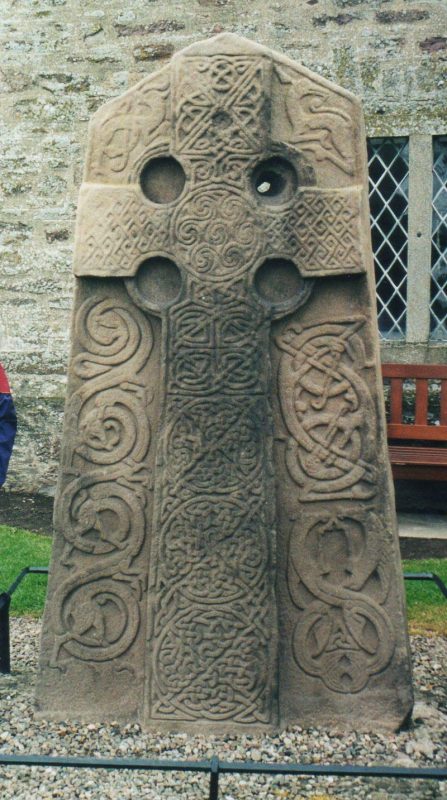
Kirkyard stone cross Aberlemno, Angus, Scotland. Photo Flickr S Rae
Relevance today of old Celtic Art
In 1901 in Scotland, Ireland, and Wales there was a renewed interest in Celtic art and history was reviewed. In Postmodern times other ethnic and gender groups reconsidered the predominant viewpoint from the white western heterosexual male. This new vision from other perspectives challenges the way we look at life and art.
At the end of the Middle Ages Greece and Rome rediscovered and revived the Classics. Classical art breaking into the Renaissance was driven by the desire to pursue perfection of the human body and to build great temples and statues. Rome strove to idealize the hero and mark great leaders in history or sculpt the Gods and Goddesses from Greco-Roman Mythology. Celtic art as tribal art from travelling people was not classical in outlook and so it was ignored. The elaborate and ornate designs of the brilliant Celtic metalsmiths did not embrace Classical art elements. A growing curiosity about the ornaments and treasures from the archaeological sites of Hallstatt and La Tene raised more questions about the people hidden away from the pages of Roman history.
Today galleries, churchyards and museums display and preserve the wonderful Celtic stones, items and ornaments that have survived. Some of the stones stand in fields and on hills. People can visit the ancient Celtic mind by viewing the art. It may be anti-classical but that does not diminish its aesthetic and cultural or artistic significance. Secrets are locked away in the symbols and motifs and people want to know more.
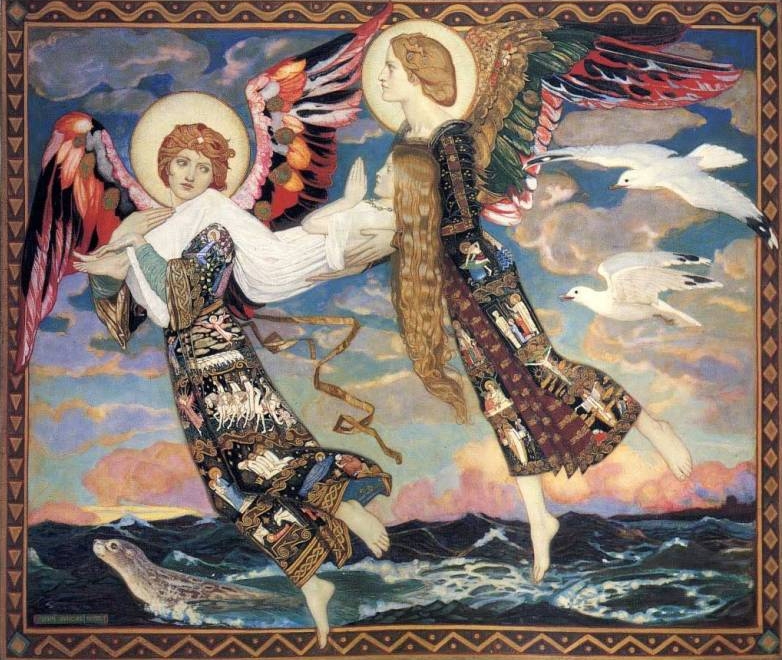
Saint Bride/Brigid-Celtic Myth /Legend
Links can be made to the more recent Scottish painter like John Duncan, a Symbolist who uses knotwork and spiral designs in the clothes and ornaments of women. Early Pictish art from Scotland has been revived or found and is studied again for the unusual symbols found on the carved ancient stones. Tattoo art today utilizes ancient Celtic designs and symbols. Celtic Crosses are used as memorial headstones in a revival of the High Cross from the Iona monastery where the Book of Kells was made. Other works are preserved and restored as historical treasures in the Isles.
Old artists influenced by the ancients and hidden for years come out of the woodwork and are revisited. For me, it is a surprising journey seeking something new from the old. It is a common phenomenon of artists to look back when contemporary art no longer inspires. Picasso is an example. He developed Cubism from studying ancient African masks as evidenced in Les Demoiselles d’Avignon. It started from there for him.
To conclude, the brilliance of the Celts lies in the ability of the artists to meld lots of influences, styles, and beliefs together. The Celtic artists were able to solve art problems no matter how difficult the medium – metal including gold and silver, stone, wood, cement, ceramic, calf vellum, bronze, and enamel. With great craftsmanship, skill, and artistic versatility the Celts were able to connect art to life, to religion, to nature and to the human spirit by adapting and mastering the technologies of the day. They never ceased to invest in the importance of drawing and balanced design, and this for me, makes Celtic art current and particularly relevant today.
These essays are copyrighted as are my original artworks. Pages can be printed out and used for educational purposes.
